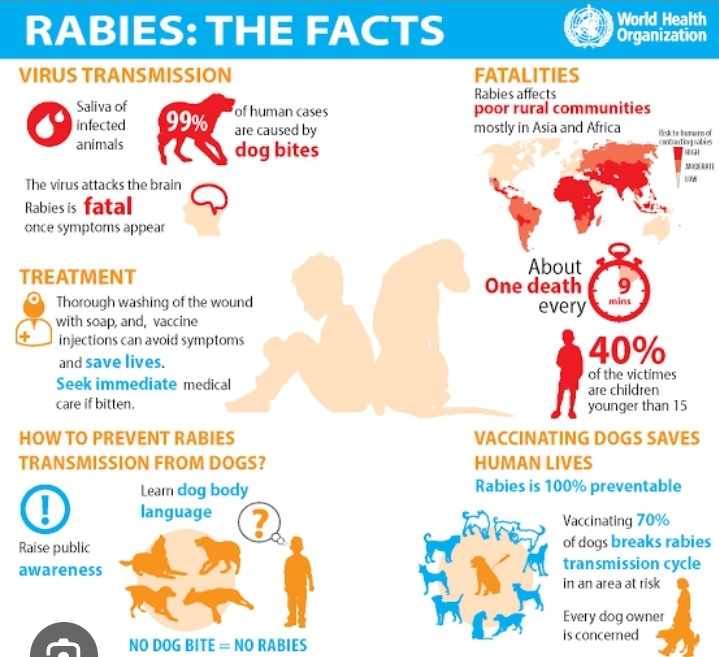
A rabies infection in dogs is a viral disease caused by the rabies virus, which affects the central nervous system and is almost always fatal once clinical symptoms appear. The virus belongs to the Lyssavirus genus and is typically transmitted through the saliva of an infected animal, most commonly via bites.
Transmission
- Bites: The primary mode of transmission is through bites from an infected animal, such as another dog, bat, raccoon, skunk, fox, or other wildlife.
- Scratches or Open Wounds: The virus can also enter the dog’s body if saliva from an infected animal comes into contact with scratches or open wounds.
- Mucous Membranes: Infection can occur through mucous membranes (eyes, nose, mouth) if they come into contact with the virus-laden saliva.

Symptoms
Rabies in dogs progresses through several stages, with symptoms becoming increasingly severe:
- Prodromal Stage:
- Behavioral changes (increased aggression, anxiety, or shyness)
- Fever
- Licking, biting, or scratching the site of the bite wound
- Excitative (Furious) Stage:
- Hyperactivity and restlessness
- Aggression towards people, animals, and objects
- Hypersensitivity to light, sound, and touch
- Excessive salivation and difficulty swallowing
- Disorientation
- Paralytic (Dumb) Stage:
- Progressive paralysis, starting from the hind limbs
- Drooping jaw and inability to close the mouth
- Difficulty swallowing, leading to foaming at the mouth
- Respiratory distress due to paralysis of respiratory muscles
- Coma and death
Diagnosis
Diagnosing rabies in dogs involves:
- Observation of Symptoms: Noting the clinical signs and behavioral changes.
- Laboratory Tests: Post-mortem examination of brain tissue is the most definitive diagnostic method. Ante-mortem tests include saliva, serum, spinal fluid, and skin biopsies.
Treatment
Once clinical symptoms appear, rabies is almost always fatal in dogs. There is no effective treatment for rabies once symptoms manifest. Prevention through vaccination and prompt action after potential exposure is crucial.
Prevention
- Vaccination: Regular rabies vaccinations for dogs are the most effective way to prevent the disease.
- Avoiding Exposure: Keeping dogs away from wildlife and stray animals can reduce the risk of exposure.
- Public Health Measures: Implementing control measures such as stray dog population management and public education about rabies prevention.
Importance of Early Action
If a dog is bitten or exposed to a potentially rabid animal, immediate veterinary care is essential. Post-exposure prophylaxis (PEP), which includes wound cleaning and a series of rabies vaccinations, can prevent the virus from taking hold if administered promptly.
Rabies remains a serious and life-threatening disease, but it is preventable through effective vaccination and control strategies.
Rabies has profound and severe effects on animals, impacting their behavior, health, and ultimately leading to death if not prevented through vaccination. Here are the primary effects rabies can have on animals:
Behavioral Changes


- Increased Aggression: Infected animals often exhibit uncharacteristic aggression, attacking other animals and humans without provocation.
- Fearfulness or Shyness: Some animals may become unusually timid or shy, which is a marked change from their normal behavior.
- Restlessness and Hyperactivity: Many animals display signs of hyperactivity, restlessness, and an inability to stay still.
- Unusual Vocalizations: Dogs and other animals may bark, growl, or vocalize in unusual ways.
Neurological Symptoms
- Confusion and Disorientation: The animal may appear confused, disoriented, and have trouble navigating familiar environments.
- Hypersensitivity: Increased sensitivity to light, sound, and touch, often leading to exaggerated responses to stimuli.
- Paralysis: Progressive paralysis often begins in the hind legs and spreads to other parts of the body. This can lead to a drooping jaw, inability to swallow, and respiratory distress as the muscles involved in breathing become paralyzed.
- Seizures: Seizures and convulsions may occur as the disease progresses.
Physical Symptoms
- Excessive Salivation: Due to difficulty swallowing, infected animals often drool excessively, which is one of the classic signs of rabies.
- Hydrophobia: While more commonly noted in humans, animals may also exhibit a fear of water due to spasms in the throat muscles, making it difficult and painful to swallow.
- Loss of Appetite: Infected animals may refuse to eat or drink.
- General Weakness: As the disease advances, the animal becomes progressively weaker.
Fatal Outcome
- Coma and Death: Rabies invariably leads to coma and death within days to weeks after the onset of clinical symptoms if not treated promptly. In animals, this usually occurs within a week to ten days of symptom onset.
Transmission to Other Animals and Humans
- Spreading the Virus: Infected animals can transmit the rabies virus to other animals and humans through bites, scratches, or contact with saliva, making them a significant public health concern.
- Read Also about Bovine tuberculosis in livestock
Impact on Wildlife and Domestic Animals
- Wildlife: Rabies can have devastating effects on wildlife populations, particularly in species that serve as major reservoirs for the virus, such as bats, raccoons, skunks, and foxes.
- Domestic Animals: Unvaccinated domestic animals, especially dogs and cats, are at high risk of contracting and spreading rabies.
Preventive Measures
- Vaccination: The most effective way to prevent rabies in domestic animals is through regular vaccinations.
- Control Measures: Managing and controlling stray animal populations, avoiding contact with wild animals, and implementing quarantine measures for suspected cases.
Rabies is a deadly disease that has significant impacts on both the health and behavior of animals, underscoring the importance of preventive measures and public health interventions to control its spread.

Leave a Reply